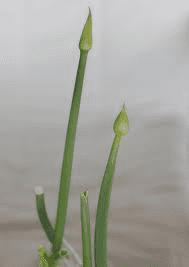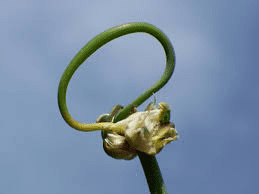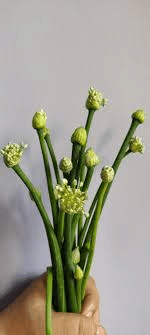The onion peduncle is an important part of the onion plant’s reproductive structure, serving as the stem that supports the flower head, or umbel, in the flowering phase. Scientifically known as Allium cepa, the onion plant features this specialized stalk as a key component of its inflorescence.
The peduncle, also referred to as the flower stalk, is a long, slender structure that extends upward from the central bulb of the onion plant. Its primary function is to elevate the umbel, which is the spherical cluster of small flowers, above the foliage and leaves. This elevation ensures that the flowers are more accessible to pollinators, such as bees and other insects, which are crucial for the cross-pollination process.
Structurally, the peduncle is typically hollow and is made up of a series of layers, including the outer epidermis and inner vascular tissues.
The epidermal layer provides protection to the internal tissues, while the vascular tissues—comprising xylem and phloem—are responsible for transporting water, nutrients, and sugars between the bulb and the flower head. The xylem carries water and minerals from the roots to the flowers, while the phloem distributes the products of photosynthesis from the leaves to the flowers.
The length of the peduncle can vary depending on the onion variety and growing conditions. In general, it is long enough to lift the umbel well above the surrounding foliage, allowing the flowers to be more visible and accessible for pollinators. The strength and rigidity of the peduncle are crucial for maintaining the stability of the flower head, especially in windy conditions or when the plant is bearing a heavy umbel.
During the flowering period, the peduncle supports the developing umbel as the flowers bloom sequentially. This arrangement allows for a prolonged period of flowering, increasing the likelihood of successful pollination. Once pollination occurs, the peduncle continues to support the umbel as the flowers develop into seed capsules.
After the flowering stage, the peduncle remains attached to the mature seed capsules until they are ready to disperse their seeds. Once the seeds are released, the peduncle eventually dries out and can be seen as part of the plant’s post-flowering structure. In some cases, the peduncle may also be used in decorative arrangements or as a component of garden displays due to its unique and attractive form.
The onion peduncle is a crucial structural component of the onion plant’s reproductive system. It supports the umbel, facilitates pollination, and ensures the successful development and dispersal of seeds. Its design and function are integral to the onion plant’s life cycle and its ability to reproduce effectively.
The Economic Importance and Uses of Onion Peduncle

1. Seed Production: The onion peduncle, which is the stalk supporting the flower umbel, is essential for seed production. It supports the flowering structure that produces onion seeds, crucial for new crop cultivation.
2. Culinary Uses: While not commonly used in cooking, the peduncle can be used as a vegetable stalk in soups and stews to add flavor, similar to how celery stalks are used.
3. Compost Material: Onion peduncles can be added to compost piles. They decompose and contribute valuable organic matter to the compost mix, enhancing soil fertility.
4. Soil Health Improvement: The decomposition of onion peduncles adds nutrients to the soil, improving its structure and fertility, which benefits plant growth.
5. Organic Farming: In organic farming practices, onion peduncles can be used as part of crop rotation and composting strategies to maintain soil health and productivity.
6. Educational Purposes: Onion peduncles are used in educational settings to teach about plant anatomy, including the role of peduncles in supporting flower structures.
7. Traditional Medicine: In some cultures, onion peduncles are used in traditional remedies for their perceived health benefits, including potential anti-inflammatory and antioxidant properties.
8. Bioenergy Production: Research is exploring the use of onion peduncles in bioenergy production, such as processing them into biofuels or biogas.
9. Sustainable Farming: Utilizing onion peduncles in sustainable farming practices helps reduce waste and supports efficient use of agricultural resources.
10. Green Manure: Onion peduncles can be used as green manure, incorporated into soil to add organic matter and nutrients, benefiting soil health.
11. Mushroom Cultivation: Processed onion peduncles can be used as a substrate or supplement in mushroom cultivation, providing nutrients that support mushroom growth.
12. Natural Dye: Onion peduncles can be used to create natural dyes for textiles and crafts, producing various shades of color.
13. Craft Materials: The fibrous nature of onion peduncles makes them suitable for use in traditional crafts and weaving projects.
14. Aromatic Products: The aroma of onion peduncles can be used in making natural fragrances and essential oils.
15. Water Filtration: Onion peduncles can potentially be used in water filtration systems to help remove impurities from contaminated water.
16. Soil Amendments: Added to soil, onion peduncles contribute to the organic matter content, which enhances soil health and plant growth.
17. Medicinal Extracts: Extracts from onion peduncles are used in some natural health products for their potential therapeutic benefits.
18. Conservation of Plant Species: Preserving onion peduncles helps in the conservation of onion varieties and contributes to overall genetic diversity.
Read Also: 23 Medicinal Health Benefits Of Dichroa febrifuga (Blue Evergreen Hydrangea)
The Products and By-products That Can Be Derived From Onion Peduncle

1. Compost Material: Added to compost piles to enrich the compost mix.
2. Culinary Stalks: Used as vegetable stalks in soups and stews.
3. Organic Farming Inputs: Utilized in composting and crop rotation to maintain soil health.
4. Soil Fertilizer: Decomposes to improve soil fertility and structure.
5. Educational Tools: Used in teaching about plant anatomy and flower support structures.
6. Traditional Remedies: Incorporated into traditional medicine for perceived health benefits.
7. Bioenergy Products: Processed into biofuels or biogas for renewable energy.
8. Green Manure: Added to soil to improve organic matter and nutrient content.
9. Mushroom Substrate: Used as a nutrient source in mushroom cultivation.
10. Natural Dyes: Used to create dyes for textiles and crafts.
11. Craft Materials: Used in traditional crafts and weaving projects.
12. Aromatic Products: Incorporated into natural fragrances and essential oils.
13. Water Filtration Media: Applied in filtration systems to remove water impurities.
14. Soil Amendments: Added to soil to enhance organic matter content.
15. Medicinal Extracts: Used in natural health products for therapeutic uses.
16. Conservation Efforts: Supports the conservation of onion species and genetic diversity.
Read Also: 25 Medicinal Health Benefits Of Astragalus amphioxys (Crescent milkvetch)
Frequently Asked Questions (FAQ’s) About Onion Peduncle

1. What is an onion peduncle? The onion peduncle is the stalk that supports the flower umbel at the top of the onion plant.
2. How is the onion peduncle used in culinary applications? It can be used as a vegetable stalk in soups and stews to add flavor.
3. Can onion peduncles be used in composting? Yes, they can be added to compost piles to contribute organic matter and nutrients.
4. How does the onion peduncle benefit soil health? When decomposed, it improves soil structure and fertility, supporting plant growth.
5. Are there any traditional medicinal uses for onion peduncles? In some cultures, they are used in traditional remedies for their perceived health benefits.
6. How is the onion peduncle utilized in sustainable farming? It is used in composting and crop rotation practices to reduce waste and maintain soil health.
7. Can onion peduncles be used for bioenergy production? Yes, they are being researched for their potential use in biofuels and biogas production.
8. What educational purposes do onion peduncles serve? They are used to teach about plant anatomy and the role of peduncles in supporting flower structures.
9. Are there any craft applications for onion peduncles? Yes, their fibrous nature makes them suitable for traditional crafts and weaving projects.
10. How can onion peduncles be used in water filtration? They have potential uses in water filtration systems to help remove impurities from contaminated water.
Read Also: Importance of Personal Hygiene and How to Improve on it

